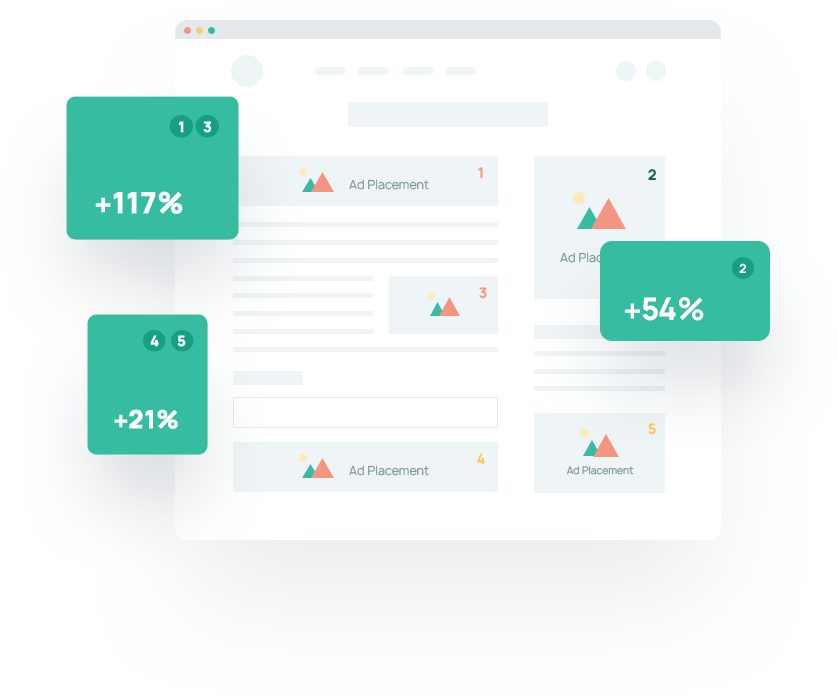Increasing your Ad Fill Rate is crucial to maximizing revenue for marketing teams and businesses in the publisher industry.
In this blog post, we will explore the concept of Ad Fill Rate and its significance in revenue generation for niche site owners. We’ll also explore factors influencing Ad Fill Rates and discuss practical strategies to optimize them.
By learning how to calculate your Ad Fill Rate accurately, you can gain valuable insights into the performance of your ad inventory. Gaining an understanding of your Ad Fill Rate can help you to make informed decisions when aiming to raise both the quality and amount of ads served on your platform.
What Does Ad Fill Rate Mean?
Ad Fill Rate is a significant metric in the ad tech world, often used to evaluate the effectiveness of an ad network. It represents a percentage that indicates the number of times an ad is successfully served to your site’s ad units from a publisher’s ad network whenever someone visits your website.
The Ad Fill Rate measures the performance of your ad network, such as Google AdSense or header bidding solutions. It’s a ratio of the number of ads served to the number of ads requested.
Ad Fill Rate values range from 0% to 100%, where a rate of 100% means that every ad request has resulted in an ad being displayed. While a rate of 0% means that no ad request has resulted in an ad being displayed.
A higher fill rate means more of your ad inventory is being used, directly increasing your ad revenue and aiding your site’s monetization efforts.
However, a lower fill rate suggests you’re not maximizing your potential ad revenue because the ads are not being served as often as possible. It could indicate issues with the ad server or a lack of demand from the ad networks.
How To Calculate Ad Fill Rate
The Ad Fill Rate is a measure that indicates how effectively your available ad space or ‘ad inventory’ is being utilized, which directly influences your advertising income.
You look at how many ad impressions you’ve had, which is basically how many ads have been displayed. Then, you divide this by the total number of ad requests you’ve received. These are the instances where advertisers have expressed interest in placing an ad on your site. Multiply the result by 100, and your Ad Fill Rate will be a percentage.
So, the formula to calculate the Ad Fill Rate becomes:
Ad Fill Rate = (Number of Ads Displayed / Total Number of Ad Requests) x 100%
We can make it more straightforward with a hypothetical situation: Let’s say you’re a website owner with ten ad slots up for grabs. Over a certain period, you’ve received 100 inquiries from various advertisers wanting to place their ads—these are your ‘ad requests’.
However, only 80 of these inquiries end up with an ad being placed and displayed on your site. Using our formula, you’ll calculate your Ad Fill Rate as: (80/100) * 100 = 80%.
A decent Ad Fill Rate is generally considered 70% or more. If you find that yours falls below this benchmark, it might be time to consider employing strategies to boost it.
It’s also worth noting that what counts as the ‘best’ fill rate can depend on many factors, like the norms for your industry or the level of competition in specific niches or geographical areas.
Getting to a 100% fill rate may not be realistic due to factors such as your users’ behavior or advertiser demand fluctuations.
Factors That Influence Your Ad Fill Rate
Navigating the complexities of your Ad Fill Rate involves more than just grasping the calculation itself. Many interconnected factors influence this rate, each worthy of careful consideration. You’ll be better positioned to optimize your digital advertising strategy with a deeper understanding of these elements.
Specific Market Or Industry Variances
The Ad Fill Rate is significantly influenced by factors such as industry variations and specific market demands. Different advertising mediums may have varying fill rates due to user behavior variations and ad inventory availability.
For example, the fill rate for podcast advertising might differ from that of online display ads because podcast listeners exhibit unique behaviors and preferences. Likewise, publishers operating within niche markets or targeting specific demographics may experience different levels of advertiser demand, leading to fluctuations in their fill rates.
Understanding these market and industry variances is crucial for publishers seeking to optimize their Ad Fill Rates. It helps them grasp the factors that contribute to variations in demand and the effectiveness of their ad inventory.
Geographic Location
Another factor that can significantly impact Ad Fill Rate is geographic location. Demographics and consumer behavior vary greatly from one region to another, so advertisers must understand the market they’re targeting.
Through geotargeting, marketers can optimize their ads by tailoring them to regions with higher demand for specific products or services.
Additionally, publishers that serve more localized content will often be able to command a premium price per impression because such content might appeal specifically to unique audiences within smaller geographic regions.
User Device Type
The type of device the user uses can play a significant role in your Ad Fill Rate. It’s essential to understand how different devices impact ad placement and viewability and the potential revenue growth that comes with optimizing for each one.
For example, mobile devices often have smaller screens than desktops, which means advertisers need to tailor their ads for smaller dimensions and take advantage of behavioral targeting to ensure their message gets across clearly. Optimizing for user device type can improve ad performance if done correctly.
Ad Blockers & Anonymous Browsers
One of the factors that can significantly influence your Ad Fill Rate is the use of ad blockers and anonymous browsers. Ad blockers are designed to remove or change ads in real-time during a user’s web browsing experience, while anonymous browsers enable users to browse the internet without disclosing their identities.
According to global reports, excessive ads and irrelevant ad messages are among the top reasons users employ resort to blocking ads. This highlights the importance of delivering targeted, high-quality ads aligning with users’ interests.
To optimize your site’s Ad Fill Rate, consider leveraging behavioral targeting techniques that help deliver personalized content based on user preferences and past behaviors.
Errors And Page Latency
Technical errors and page latency are two factors that can significantly impact the Ad Fill Rate on a website. Technical issues such as broken code or missing files can prevent ads from displaying correctly, leading to lower fill rates.
On the other hand, page latency refers to delays in loading content and advertisements due to slow server response times, large file sizes or video ads.
To prevent technical difficulties impacting your Ad Fill Rate, it’s crucial to regularly conduct checks and testing on your website’s backend operations.
Lack Of Demand
One of the most significant factors that can affect your Ad Fill Rate is the lack of demand in the market. Advertisers may not be interested in displaying ads on your site, creating a shortage of available ads to display.
To combat this problem, publishers can consider implementing dynamic or static floor prices to increase Ad Fill Rates. Floor prices are minimum bid thresholds set by publishers to ensure they receive a certain amount per impression while optimizing ad revenue potential.
Increasing floor prices can attract higher-quality advertisers and encourage them to compete for your inventory, ultimately improving your overall Ad Fill Rate.
Ad Quality and Relevance
The quality and relevance of the ads being served can significantly impact the Ad Fill Rate. If the ads are not appealing or relevant to the target audience, users may be less likely to engage with them, resulting in lower Ad Fill Rates. Advertisers must ensure that their ads are well-designed, compelling, and tailored to the interests and preferences of the intended viewers.
Seasonal Trends and Events
Ad Fill Rates can vary based on seasonal trends and specific events. For example, during holiday seasons or major sporting events, there may be a higher demand for advertising, leading to increased ad fill rates. Conversely, during slower periods or certain industry-specific events, the demand for ads may decrease, resulting in lower ad fill rates.
How To Improve Your Ad Fill Rate
You can improve your Ad Fill Rate and maximize your ad inventory by implementing effective strategies and making informed adjustments. Consider the following tactics to enhance your Ad Fill Rate and drive better results.
Use A High-Quality Ad Network
One way to do this is to increase your Ad Fill Rate is by using a high-quality ad network provider, such as our ad management network. Ad network providers help publishers monetize their online content by filling their ad slots with ads from advertisers.
When choosing an ad network provider, consider factors such as the quality of its advertiser demand and the exclusivity it offers. Working with multiple ad networks can also help maximize your fill rate by tapping into different demand pools.
Consider Behavioral Targeting
Behavioral targeting is one effective way to increase your Ad Fill Rate. This involves analyzing customer data, such as demographics and browsing behavior, to deliver ads that align with their interests and needs.
For example, if you manage a cooking enthusiast website, implementing behavioral targeting can help you display ads from kitchenware companies or food delivery services that cater specifically to home cooks based on their browsing history.
By tailoring your ads to match your target audience’s preferences, you enhance your ads’ relevance, leading to higher Ad Fill Rates.
Incorporating behavioral targeting allows you to optimize your ad inventory and improve the overall effectiveness of your advertising strategy.
Improve Your Site Speed
A vital factor in improving your Ad Fill Rate is the speed of your website. A fast-loading site creates a better user experience, resulting in longer engagement time and higher click-through rates. To enhance your site’s speed, optimize images and media, reduce HTTPS requests, and minimize redirects.
Regularly test your website’s speed using tools like Google PageSpeed Insights or GTmetrix to identify and address any latency or loading issues.
By prioritizing website speed, you create a seamless browsing experience that encourages visitors to stay longer and interact with the displayed ads, ultimately leading to an improved Ad Fill Rate.
Test Various Ad Sizes
Another effective strategy to improve your Ad Fill Rate is by testing various ad sizes. Different devices and display settings may require different ad sizes for optimal performance.
For instance, if most of your visitors come from mobile devices, smaller ads perform better due to limited screen real estate. On the other hand, larger desktop screens may benefit from bigger ads that capture more attention.
Testing different formats will not only increase your chances of filling empty slots but also help boost click-through rates (CTR) and overall revenue.
Conclusion
Improving your Ad Fill Rate is crucial for optimizing revenue and ensuring the success of your digital advertising campaigns. By understanding the factors that influence your Ad Fill Rates, such as specific market or industry variances, geographic location, user device type, and user behavior, you can take steps to improve it.
Applying strategies such as behavioral targeting, improving site speed, testing various ad sizes to optimize performance, and partnering with a reliable ad network can significantly help increase your Ad Fill Rates.
Here at Newor Media, we have a strong track record and industry expertise. We connect publishers with ideal advertisers and deliver relevant ads for their sites.
To further explore your options, you can use our earnings calculator or contact our team to create a customized plan tailored to your needs.

